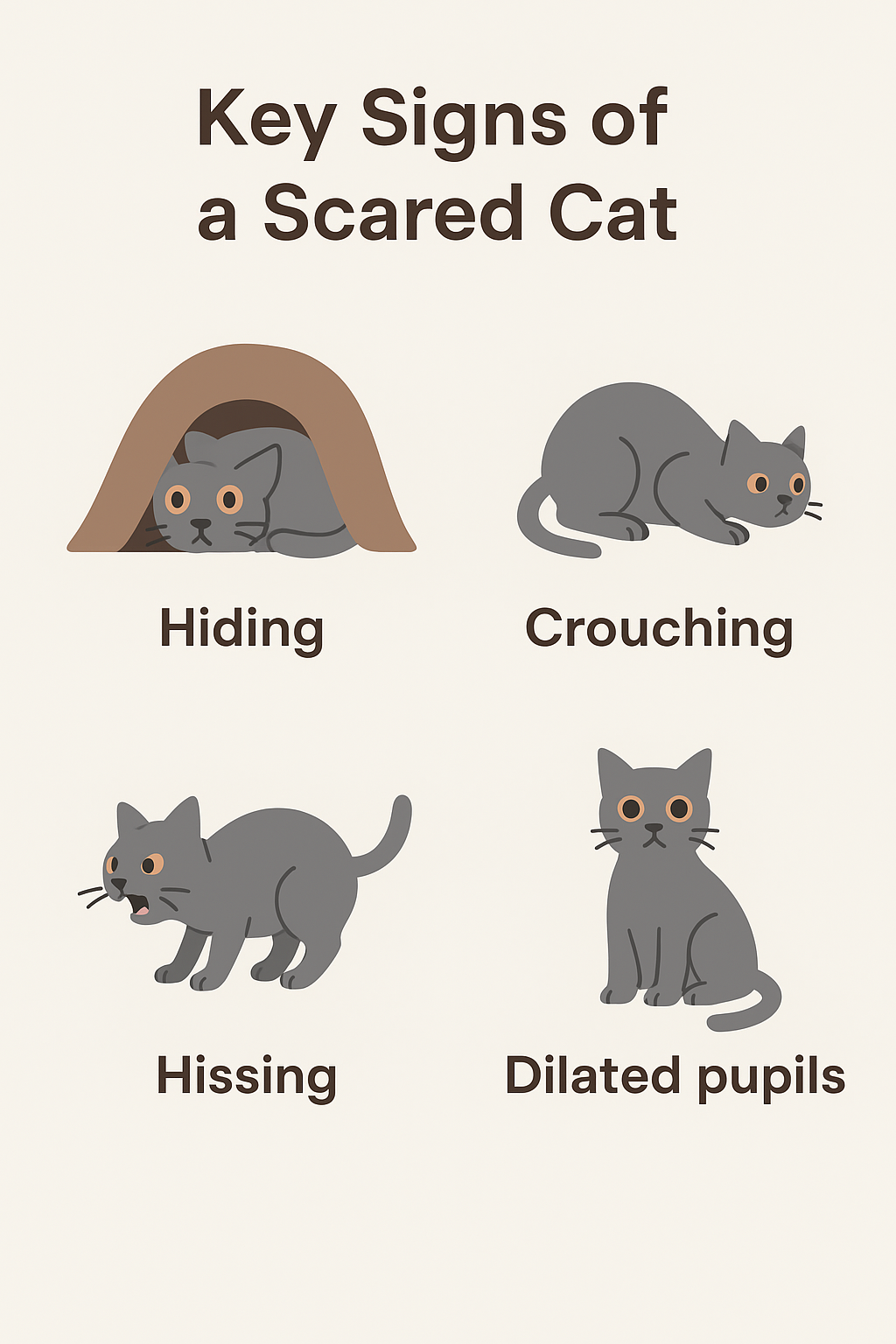Post Disclaimer
Catopedea shares information for educational and general interest purposes only. Our content is not a substitute for professional veterinary advice, diagnosis, or treatment. Always consult a licensed veterinarian for concerns about your cat’s health, diet, or behavior.
Cats are fascinating creatures with subtle ways of communicating. Unlike dogs, who wag their tails or bark to show how they feel, cats rely heavily on body language to express emotions. If you’ve ever seen your cat suddenly puff up, flatten its ears, or tuck its tail under its body, you’ve witnessed the signs of fear.
Understanding scared cat body language isn’t just about curiosity it’s essential for keeping your cat comfortable, safe, and stress-free. By recognizing these signals, you can respond appropriately, strengthen your bond, and prevent situations where fear turns into aggression.
In this guide, we’ll explore every aspect of feline fear communication: from ears and tails to whiskers and posture. You’ll also learn what triggers fear, how to calm a frightened cat, and when it’s time to seek professional help.
Why Do Cats Get Scared?
Cats are both predators and prey in nature, which makes them extra cautious. While they can hunt small animals, they’re also vulnerable to bigger threats. This dual role has shaped their instinctive responses: when something feels off, they prefer to flee, hide, or defend themselves.
Common triggers for cat fear include:
- Loud noises (fireworks, vacuum cleaners, thunderstorms)
- Strangers or unfamiliar pets entering the home
- Sudden movements or handling they don’t expect
- Veterinary visits and car rides
- Past trauma (especially common in rescue cats)
By learning to spot fear body language, you’ll know whether your cat is simply startled or deeply stressed.
Key Signs of a Scared Cat

1. Ears Pinned Back
According to veterinary experts at PetMD, cats often widen their eyes and pin their ears back when they feel threatened.
2. Dilated Pupils
Fear causes pupils to expand, making the eyes look wide and round. If you notice this along with crouching or hiding, your cat is likely frightened.
3. Arched Back with Fur Puffed Up
The classic “Halloween cat” pose—arched spine and fluffed tail—is a defensive tactic. It makes the cat appear larger to scare off threats.
4. Tail Tucked or Flicking
- Tucked under body = fear or submission.
- Rapid flicking or lashing = agitation and warning to stay away.
5. Whiskers Pulled Back
Relaxed whiskers fan out, but scared cats pull theirs close to the face to protect them.
6. Crouched Posture
A frightened cat may crouch low with paws tucked under, ready to bolt at any second.
7. Growling, Hissing, or Spitting
Vocal cues are part of scared cat body language. If your cat hisses while backing away, it’s saying: “Give me space.”
8. Freezing or Refusing to Move
Some cats respond to fear by going completely still, almost like “playing dead.”
Scared Cat Body Language vs. Aggressive Cat Body Language
It’s easy to confuse fear with aggression, but the difference matters. A scared cat wants to escape, while an aggressive cat prepares to attack.
- Scared cat: crouched, ears back, tail tucked, avoiding eye contact.
- Aggressive cat: stiff posture, direct stare, tail up or thrashing, growling loudly.
Knowing the difference helps you avoid making fear worse.
Reading Fear Through the Tail
The tail is one of the most expressive parts of cat communication.
- Low and tucked = fear, submission.
- Straight up but puffed = startled or defensive.
- Thrashing side to side = frustration, warning.
- Curved gently around the body = caution but not extreme fear.
Next time your cat’s tail moves suddenly, observe the rest of the body for context.
Reading Fear Through the Ears
Ears are like little radar dishes they move constantly.
- Forward ears = relaxed, curious.
- Slightly sideways = cautious or unsure.
- Flat and pinned back = scared or defensive.
Cats in fear often pair pinned ears with crouching or hiding.
Reading Fear Through the Eyes
The eyes reveal so much.
- Normal pupils = relaxed.
- Wide pupils = startled, excited, or scared.
- Squinting or half-closed = stress relief, sometimes fear.
Always interpret eyes with posture. A playful cat can also have dilated pupils but if the body is crouched, it’s fear. If you’d like a deeper dive into how eyes reflect different moods beyond fear, check out our guide on Decoding Cat Eye Language: Understanding Feline Emotions.
Scared Cat Facial Expressions
Your cat’s face holds subtle fear cues:
- Tight jaw
- Flattened whiskers
- Wrinkled nose
- Mouth open (hissing)
Recognizing these alongside body cues helps you get the full picture.
Why Understanding Fear Matters
Fear isn’t just uncomfortable it can harm your cat’s health. Chronic stress weakens the immune system, affects digestion, and may even shorten lifespan.
When fear goes unaddressed, it may lead to:
- Aggressive outbursts
- Litter box avoidance
- Over-grooming or hair loss
- Hiding and social withdrawal
By learning to read scared cat body language, you protect your cat’s well-being.
How to Calm a Scared Cat
1. Give Space
Never chase or grab a fearful cat. Instead, let them hide until they feel safe.
2. Provide Safe Zones
Cat trees, covered beds, or boxes give your cat secure spaces to retreat.
3. Use a Soft Voice
Speak gently, avoid loud tones, and blink slowly to reassure them.
4. Avoid Eye Contact
A direct stare feels threatening. Instead, turn slightly away to reduce pressure.
5. Offer Familiar Scents
Cats feel safe with scents they recognize. Place blankets or toys near them.
6. Try Calming Products
Pheromone sprays and diffusers (like Feliway) help reduce fear.
7. Gradual Exposure
If fear is linked to a trigger (like visitors), introduce it slowly with positive reinforcement.
When to See a Vet or Behaviorist
Sometimes fear stems from pain or medical conditions. Seek help if your cat:
- Suddenly becomes fearful without clear reason
- Hides constantly for days
- Shows aggression linked to fear
- Stops eating or grooming
A vet can rule out health issues, while a feline behaviorist can help with long-term fear.
Helping a Rescue or Stray Cat
Rescue cats often carry trauma. They may:
- Flinch at sudden movements
- Hide for long periods
- Display extreme scared cat body language
Patience is key. Offer food at consistent times, avoid forcing interaction, and celebrate small progress like taking food near you without running.
How Children Should React to a Scared Cat
Kids may not understand cat fear signals. Teach them to:
- Never chase a hiding cat
- Avoid pulling tails or ears
- Use quiet voices
- Let the cat come to them
This protects both the child and the cat.
Building Trust With a Fearful Cat
Trust takes time. Use these steps:
- Sit quietly near their hiding spot without touching.
- Offer treats by hand (without forcing).
- Play with interactive toys (like a feather wand) from a distance.
- Respect boundaries.
Over weeks or months, your cat will associate you with safety.
My Cat’s Body Language Changed Overnight Why?
Cats sometimes shift from confident to fearful quickly. Possible reasons:
- New environment (moving homes)
- New pets or people
- Loud construction nearby
- Health issues causing discomfort
If the change seems sudden and severe, consult your vet.
Frequently Asked Questions
Q: How do I know if my cat is scared or just playing?
A playful cat may chase or pounce but will have relaxed ears and return for more play. A scared cat avoids eye contact, crouches, or hides.
Q: Should I pick up my cat when it’s scared?
No. Forcing contact increases fear. Let your cat come to you instead.
Q: Do scared cats ever bite?
Yes. A fearful cat may lash out if cornered. Always give them an escape route.
Q: Can cats grow out of fear?
Yes, with patience and positive experiences, many cats become more confident.
Final Thoughts
Recognizing scared cat body language is one of the most important skills for any cat owner. From flattened ears to a tucked tail, these signals reveal how your cat feels in stressful moments. By respecting their boundaries, providing safe spaces, and responding calmly, you’ll build trust and reduce fear-based behavior.
At the end of the day, fear is just another way your cat communicates. By learning to listen, you create a home where your feline friend feels secure, loved, and understood.



Pingback: Toxic Plants and Products for Cats | Complete Safety Guide - catopedea.com
Pingback: Tabico Cat: The Rare Beauty of Tabby-Calico Cats - catopedea.com